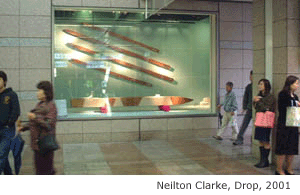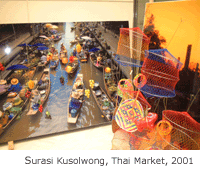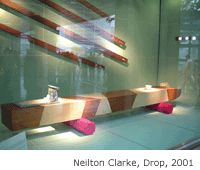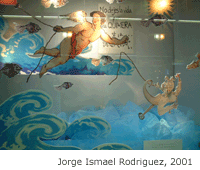
Like a Trojan horse the work of Thai artist, Surasi Kusolwong,
has snuck into the citadel of consumerism -- the Japanese department store.
Surasis art is about giving, not buying or selling. It usually involves
the free distribution of knickknacks from a Thai market to up-market contemporary
art gallery-goers around the world.
This is his first piece sited in a store, the Isetan in Tachikawa, and
generated mad shopper scenes as people pressed to receive his market offerings.
This opening frenzy was recorded on video and is on display near the stores
main entrance on the second floor. The video is surrounded by a few remaining
samples, which are set against large photographic images of their market
origins.
These plastic trinkets and cheap toys make a colorful yet humble contrast
to the consumer glitz that surrounds them. This new stealth approach,
of sneaking art to the people, is part of Tachikawa International Art
Festival, 2001.
Conceived of and directed by Fram Kitagawa, Tachikawa International Art
Festival, like his other art projects, is interwoven into a social redevelopment
project. Tachikawa once a military base, is now a thriving and expanding
urban center in the Tokyo Metropolitan area.
Art is a focal point in the redevelopment plan. As part of this festival
about 16 international artists are exhibiting work in various locations
around the downtown region of Tachikawa. Also concealed among the designer
labels in the Isetan shop windows and part of the festival, are radiantly
colored and embroidered traditional clothing from Africa.
An antique toilet, a tea cup, coil of rope, huge wooden needles, and oversized
tea towels, combine in an enigmatic installation by Australian artist
Neilton Clarke. His piece titled 'Drop' is like a word association game
with various elements in the display connecting with the title to give
multiple readings.
From teardrop to the verb-form, 'dropped, the associations run freely
through the work, revealing the complexity and humor of language like
a good English teacher. In spite of the disparate meanings in the installation,
it has a strong coherence through color and form.
The backdrop to the piece, like much of Tokyo, is covered in tiled panels
and each element has a familiar, antiqued patina. In the adjoining Granduo
store window in the main station entrance, is a piece by Mexican artist
Jorge Ismael Rodriguez.
It is done in the style of pop-up childrens book illustrations where
Rodriguez has hung painted cut outs of his undersea fable. Linda Dennis
paintings in the Shin Suzuharu building deal with tradition. Dennis has
reduced various patterns used in traditional art and craft to simple geometric
forms and then covered them in layers of paint. Scraping away varying
amounts of paint by the public reveal elements of the patterns hidden
underneath.
Included in the festival, from November 2 - 10 in the Amyu Tachikawa Exhibition
Space near the civic offices (south exit from the station), is a display
which includes the work of international artists, Francisco Infante (Russia),
Do-Bold (Mongolia), Wang Xiao Ming (China) Lee Sungbo (Korea) and Toho
Shozen (Taiwan).
Concurrently in this space is a selection of work by international students
from Tokyo National University of Fine Arts and Music. A visit to the
Tachikawa International Art Festival is an odyssey thorough modern suburban
Tokyo and there is much to discover.
On weekends, there are art associated events and workshops connected with
the festival, as well as, a fine permanent display of contemporary outdoor
sculpture. However, not everything is easy to find in the area nor always
open and I strongly recommend checking the festival website or telephoning
for program details, dates and times.


